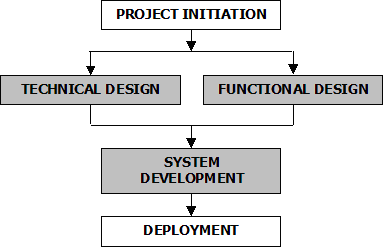|
QTECH is focused on software development / systems delivery services, specifically for the creation of enterprise scale applications deployed within corporate intranets and extranets. The mission of this division is to provide the most cost-effective and reliable custom software development services for its clients.
QTECH’s services focus primarily on the Technical / Functional Design and System Development phases of the System Development Lifecycle, however, QTECH is often called upon to contribute its expertise to the Project Initiation and Deployment phases.

Figure 1 - System Development Lifecycle
QTECH’s success in business applications development is due to its unmatched ability to use Java’s object-oriented environment, QTECH’s pre-developed application
components and frameworks, and its broad experience to rapidly create custom business applications.
QTECH’s Java software development factory is well equipped to handle development of significant enterprise and eBusiness solutions based on Java and related technologies,
Web Services, Service Oriented Architecture (SOA) and deployed on a variety of browsers, desktops and servers.
QTECH offers the following services:
Project Initiation Phase
- Technology Review and Survey: Review the use of IT within the organization and within the context of the industry at large and identify opportunities for improving the organization’s competitiveness through the application of appropriate information technologies.
- Information Technology Strategic Plans: Expands on a Technology Review and Survey to create a strategic plan that anticipates and addresses the organization’s challenges and opportunities into the future.
- Business Case Development: Includes problem definition, cost / benefit analysis, definition of project objectives, scope and budget. This service produces a clearly articulated business case for the project, and a high level plan for its execution through successive phases.
- Migration Plans: Assist the organization to plan the migration of parts of IT infrastructure to take advantage of new technologies and application systems.
Technical Design Phase
- Technology research, product selection: Exploratory work to flush out technical uncertainties, evaluate new products / technologies, prototype difficult integration points, resolve technical problems and choose the most appropriate and reliable technologies. This is often done in conjunction with, or as a prelude to the Technical Architecture activities. This is of great value in an ever-changing IT field, as it reduces the technology risk by fostering a better understanding of potential fit of available technologies and products to the system requirements.
- Technical Architecture: Identify the major subsystems and external systems of the overall system, the integration points and interfaces between the various systems, consider the cost, performance, expandability, reliability, and security requirements, and incorporate these into high-level technical design that will best support the functional requirements of the system.
Functional Design Phase
- Application / Information Architecture: Analyze the high level functional and informational requirements of the business problems and opportunities. Define high level architectures and strategies that identify the applications, functionalities, and information that will be required to address the problems and opportunities. Consolidate these into a roadmap to address the Application and Informational needs of an organization.
- Functional Analysis & Design: Working with the users of the system, analyze and express their requirements as accurately as possible. Create functional designs, data / process or object models, and/or functional prototypes, to be transferred to System Development.
System Development Phase
- Design Validation: Perform a review of designs created in previous phases and compare the original business conditions that gave rise to the business case. Evaluate the impact of changes given the proposed solution, the current state of technology, and the business environment. Assess the fit of the proposed solution as designed to the current needs of the organization and recommend a course of action to complete the project.
- Detailed Design, System Construction and Integration: Combine the Technical Architecture and the Functional Designs into a detailed specification for the construction of the various subsystems and interfaces, customization / configuration of any COTS, and their deployment into a production environment. Refinement of design
artefacts from the previous phases and the creation of detailed object models, interaction models, document outlines, construction/integration, test and delivery plans.
Execute the construction/integration plan, implementing the detailed specifications and applying the coding standards. Execute the test and delivery plans to deliver the completed system. Provide support during the Client Acceptance testing process.
System Deployment Phase
- Installation, Training and Support: Setup and configure the delivered system in the production environments, train users, administrators and/or trainers, provide ongoing operational support for the deployed system.
|

